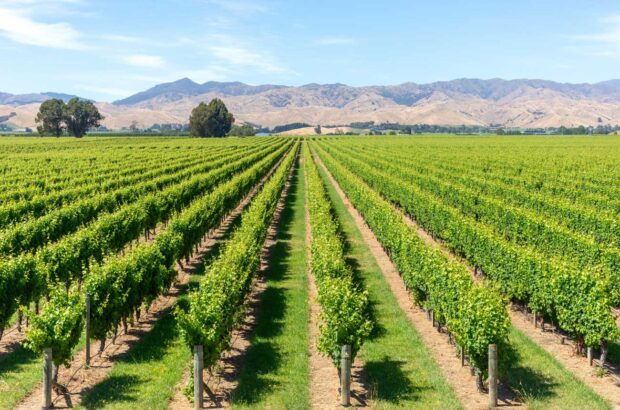When it comes to sourcing some of his coastal gin botanicals, James Harrison-Allen finds himself in a rather unusual position – he has to apply for a permit from King Charles III.
The founder and director of Still Wild, a vermouth and gin distillery based in Pembrokeshire, Wales, forages a large proportion of his ingredients, and has to get permission from the King in order to source the seaweed that he uses.
‘If you want to [forage] any wild plant for any kind of business, it always has to be done with permission, and technically the royal family owns the area of the seabed up to the high-tide mark,’ he explains as we contemplate his diminutive production facilities in the south of the county in southwest Wales.
‘So we have to get royal permission to pick the seaweed. There’s one beach we have a licence for. You write an application with a map, saying what you’re picking and how much, and pay a fee.’
DWWA results out 19 June!
Be the first to know: Subscribe to the DWWA newsletter
Still Wild is part of a growing band of coastal distilleries that are taking inspiration from their local natural environment, finding various ways to evoke the sea in the spirits they produce.
And while the UK appears to be leading the way, with a large selection of coast-inspired gins from all around its four nations, distilleries from across the world are also getting in on the act.
So what exactly defines a gin as being ‘coastal’, apart from the physical proximity of a distillery to the sea? While no official definition exists, there is common consensus among the producers to whom I spoke. ‘A gin can be described as coastal when it incorporates botanicals that evoke the essence of the seaside environment,’ opines Oliver Chapman, brand experience manager at Bullards Spirits in Norfolk. ‘This may include ingredients with briny, saline or herbal qualities, as well as those that capture the freshness and vitality of coastal landscapes.’

Bullards Coastal Gin features several coastal botanicals
Marine magic
Seaweed is one of the coastal botanicals most commonly incorporated in gin. With about 650 species found in UK waters, there’s a wide variety to choose from, all with different flavour profiles.
Skagerrak is a Nordic gin created by six bartenders from Denmark, Norway and Sweden. The team tested ‘most [seaweed] varieties that are commercially available’, recalls Morten Paulsen, product development manager for the Anora Group, which owns the Skagerrak brand. ‘But when we started testing them, it became clear that most of the
varieties only provided a quite heavy “sea” aroma without much other nuance. Dulse was on our list from the beginning, since it has quite a long culinary history going back to Viking times. The plant itself is very thin and delicate.’
Back in England, the Cornish Distilling Co’s Bude Gin uses kelp and bladderwrack. ‘Bladderwrack is the seaweed you see when you go to the beach,’ says Tom Read, head distiller at The Cornish Distilling Co. ‘It’s a very powerful flavour, so it has to be used sparingly, or else it dominates. Kelp gives a subtle umami savouriness. Overall, seaweed adds an extra layer of flavour – a bit of minerality. It has a sort of ozone quality, with some iodine and rockpool.’

James Harrison-Allen forages for seaweed – with royal approval. Credit: Tom Joy
Outside the box
It’s not simply flora that’s being used to make coastal gins – fauna is also on the menu, as the Isle of Bute Distillery demonstrates with its Oyster Gin. ‘We shuck fresh Loch Fyne oysters and place the shells in our botanical basket, [which] sits within Audrey, our copper pot still,’ explains Imogen Holland, distiller and brewer at the distillery.
‘We looked at incorporating both the shell and the mollusc in our original batches, [but] quickly realised the mollusc was overpowering and preferred the delicate balance that the shell added to the gin. Our first attempts to distil with the shells brought a nice savoury, salty flavour to the gin.’
Japanese gin brand Etsu takes things even more literally, adding seawater to its Pacific Ocean Water Gin. ‘Etsu is made at the Asahikawa Distillery on Hokkaido [the northernmost of Japan’s main islands], so it’s surrounded by the sea,’ explains Cécile Frapsauce, marketing director at BBC Spirits, the French company that owns Etsu. ‘We have to go more than 2,000m from the coast, and we take [the water from a] depth of more than 300m. It goes through six filtrations and other treatments.’
The seawater is added during the stage in which the botanicals are macerated in alcohol before undergoing distillation, and when the alcohol level is reduced following distillation. Most of the water used is actually purified spring water from the Taisetsu mountains. ‘We only use a touch of ocean water because it’s very salty,’ says Frapsauce.
Exploring seaside botanicals
Coastal botanicals don’t have to be sourced from below the high-tide line. Here, distillers tell us about their other ingredients from the seafront.
‘Marsh samphire, sea aster and sea purslane are native coastal plants found in Norfolk. Marsh samphire imparts a salty, briny flavour reminiscent of the sea, while sea aster adds a subtle herbal note with hints of saltiness. Sea purslane contributes a slightly tangy and succulent flavour.’ Oliver Chapman, Bullards Spirits
‘The sea buckthorn has become an iconic berry in Nordic cuisine. In the gin it provides a sweet, fruity taste to the distillate, which rounds off and balances the other tastes.’ Morten Paulsen, Skagerrak
‘Rock samphire gives a zesty saltiness [to gin]. If it rains, we won’t harvest for three days, to allow the salt crystals to build up on the leaves again.’ Xavier Baker, Mermaid Gin
A drop in the ocean
Despite all of these wonderful ingredients that evoke the seaside, the coastal gins featured here are all still juniper-forward in style. The savoury, saline characters that are brought to the spirits by some seaweeds and coastal plants are excellent complementary flavours to juniper and citrus, adding an extra dimension – often a base note – to the brighter characteristics of the more classic gin botanicals.
This added complexity appears to be teased out, and often amplified, by tonic water. The overall result of mixing coastal gins with Mediterranean or Indian tonic water is a collection of refreshing, bracing G&Ts with lingering iodine and ozone notes.
These gins are more than just spirits that use coastal botanicals, however – they’re an embodiment of a way of life for the distillers who are based in these environments. They are an expression of terroir, and a way to demonstrate how businesses can produce more sustainably.
‘We have a wind turbine that powers our electric stills, so they are powered by the wind that blows off the Atlantic,’ explains Cornish Distilling Co’s Read. ‘We have very strong ties to the sea. We spend a lot of time at the beach – it’s our life. We want to do our bit where we can.’
Seaside specials: Foster’s top six coastal gins
Bude Cornish Dry Gin
Cornwall, England
From the Cornish Distilling Co and made with kelp and bladderwrack, this has a light and silky mouthfeel, with juniper, sappy pine, lime and a refined savoury foundation – sea salt is present, with a drying effect on the mid-palate, alongside iodine, moss and rockpools. Sea spray in a glass. Alcohol 40%
Bullards Coastal Gin
Norfolk, England
Packed full of coastal botanicals in the form of marsh samphire, sea aster and sea purslane, this gin is zippy and bracing. Sea salt-sprinkled pine fronds and juniper berries lead the charge with cooling anise, sweeter liquorice root and wooden ice lolly stick on the finish. Alc 40%
Etsu Pacific Ocean Water Gin
Hokkaido, Japan
Made, as the name suggests, with water taken straight from the Pacific ocean. This has a lovely bright, lifted nose that combines notes of yuzu, lemon, pine and juniper with sea salt and ozone, followed by a drying, viscous, very saline and briny palate, showing sea shells, juniper, more sappy pine and white pepper. Alc 45%
Isle of Bute Small Batch Oyster Gin
Isle of Bute, Scotland
The addition of Loch Fyne oyster shells lends a very subtle seaside character to this gin, which offers notes of juniper, lemon and lime, cooling spearmint, drying black pepper, vegetal oyster leaf and just a whisper of brine. The addition of tonic water really amps up the coastal qualities of this spirit. Alc 43%
Skagerrak
Oslo, Norway
Created by six top bartenders from three Nordic countries and inspired by the Skagerrak strait. Incorporates botanicals such as dulce seaweed, sea buckthorn and elderflower. A slightly sweet impression upfront before a hit of juniper comes in, soon joined by the sour fruit tang of sea buckthorn, pebbles and iodine. Alc 44.9%
Still Wild Coastal Gin
Pembrokeshire, Wales
Created to make the perfect Martinis and Negronis with Still Wild’s own vermouths, this gin is made with seaweed, rock samphire, gorse flower and sea buckthorn. Subtle and balanced, it has a beguiling mix of juniper, sweet liquorice and savoury seaweed with a mineral, graphite finish. Alc 37.5%






